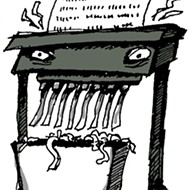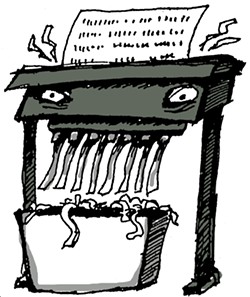[
{
"name": "Newsletter Promo",
"id": "NewsletterPromo",
"class": "inlineCenter",
"insertPoint": "4",
"component": "15264767",
"requiredCountToDisplay": "0"
},
{
"name": "Ad - Medium Rectangle CC01 - 300x250 - Inline Content",
"class": "inlineCenter",
"insertPoint": "8",
"component": "15582119",
"requiredCountToDisplay": "12"
},{
"name": "Ad - Medium Rectangle LC01 - 300x250 - Inline Content",
"class": "inlineCenter",
"insertPoint": "18",
"component": "15582122",
"requiredCountToDisplay": "22"
},{
"name": "Ad - Medium Rectangle 9 - 300x250 - Inline Content",
"class": "inlineCenter",
"insertPoint": "28",
"component": "15582121",
"requiredCountToDisplay": "32"
}]
If nuclear energy, offshore wind energy, and solar energy are all bad for San Luis Obispo County's environment and therefore its residents, and we don't want battery energy storage anywhere near us, what should we generate and store our electricity with? Coal?
That's really bad for the environment, too. Hydroelectric dams? Bad for the watershed, bad for the fish.
I guess you could put solar panels on your roof, as long as your neighbor doesn't complain about the unwanted glare and their interrupted viewshed or file an appeal to the permit you received to put them there in the first place. But putting acres of solar panels in SLO County? That was a battle with environmentalists.
Bicycle power. It's the only way. We'll use people power to energize our houses, run our air conditioners, refill our Tesla batteries, and run our internet. We can all commute to work with bicycles that are essentially two-wheeled batteries and plug them in when we get back home! But wait. What about at work? Stationary bike desks? Sounds like worker abuse.
And people hate bike lanes, too! What, oh what, are we going to do?
You can't use uranium here, you can't build turbines there, you can't generate energy anywhere!
Ted Key from Cambria recently told the Port San Luis Harbor District that offshore wind is no bueno.
"If it's built, it's going to take a huge bunch of machines that are fossil fuel dependent; each one is going to take hundreds and hundreds of gear oil gallons that have to be replaced every six months," he said during a July 23 meeting. "How does that make any sense to get us off of fossil fuels? It really doesn't."
Doesn't it make more sense than burning coal though, Ted? We have to wean ourselves somehow. We can't just quit cold turkey in this world built on petroleum. And doesn't it make more sense than living next to the potential for nuclear annihilation from Diablo Canyon Power Plant, which generates almost a tenth of the state's power supply. We have to replace that energy with something if we want nuclear to disappear, Ted!
He wasn't the only one who showed up to the meeting that day to tell the Harbor District commissioners exactly what he thought of the offshore wind farms. Those things are going to suck! The only problem for district commissioners, though, was that they weren't voting on whether to move forward with putting wind turbines in the water off California's coast—they were just voting on whether to study what would happen/needs to happen to turn the port into one that supported such a project.
They're different! Kind of.
Some of the Harbor District commissioners were miffed that the public dared show up to weigh in on the viability of the farms themselves. Commissioner Drew Brandy got a little snappy with the crowd.
"The Harbor District cannot say yes or no on wind power or suggest anything else for power," he said. "We are here to talk about this study, about what might happen in the harbor, whether we like it or not. That is what the issue is tonight, not wind power. We have about as much control over that as anybody else does. Each one of you has as much power as I do."
Supporting wind power is different than supporting wind power, you dig?
It really didn't help that the guy representing the company that would conduct the study spoke with obvious bias about wind power and the project's potential moving forward. He was excited!
Brian Sabina from Clean Energy Terminals, which will conduct the study, seemed super jazzed about wind power and its ability to transform the local economy, provide jobs, and generate clean energy.
"One of the reasons we started Terminals is because we realize there's a big opportunity for communities across the country to benefit from what is a multi-billion-dollar new maritime and energy industry happening off the coast," he said during the meeting.
Engaging with stakeholders, Sabina said, is going to build a better project.
"We hope to build a long-term relationship with many of the stakeholders who are here today so that we can build those values," he said.
Is he talking about the study of Port San Luis potentially becoming an operations and maintenance port for offshore wind facilities or Port San Luis actually becoming one? His language is a little confusing.
Kind of like this measure in Grover Beach: G-24. The citizen-initiated measure seeks to overturn a December resolution increasing water and wastewater rates in the city. It's called the "Initiative to Repeal Water and Wastewater Rates."
What's confusing is the fact that the Grover Beach City Council already repealed that resolution, kind of. The City Council actually voted to revert its water rates to their old levels after Grover H2O had already turned in the signatures it needed to qualify the petition for the ballot. What the city didn't do, though, was revert those wastewater rates.
If it was going to do one, it should have done the other to make things less confusing for voters. Now, they have to decipher for themselves what they're actually voting on—which is repealing the wasterwater rate increase, even though the measure states otherwise. It's a mess. Δ
The Shredder thinks Grover Beach is a mess. Send thoughts to [email protected].
What do local college-age students need the most help with?
Latest in Shredder
Comments (3)
Showing 1-3 of 3
Readers also liked…
-

It ain't pretty
May 4, 2023 -

Carrot kingpins
Aug 17, 2023









